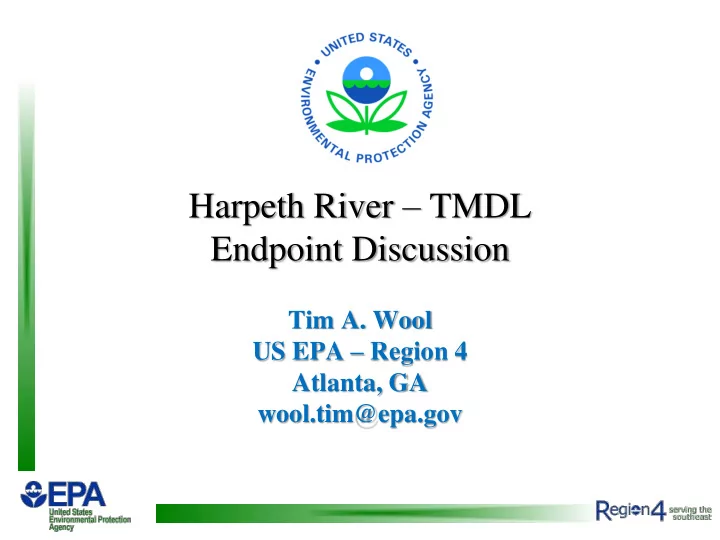

Harpeth River – TMDL Endpoint Discussion Tim A. Wool US EPA – Region 4 Atlanta, GA wool.tim@epa.gov
Overview • Life of a TMDL Developer – Listing for Nutrients • Got Listed . . . . • What is the Standard ? – Total Nitrogen – Total Phosphorus – Chlorophyll a – Dissolved Oxygen – What do you mean a narrative criteria • Imbalance, huh? • Free From . . . . • I need a number!
Developing a TMDL Target • Is a TMDL Target the Same as WQS? – No, it is an interpretation of a narrative • Imbalance of flora and fauna • Free from . . . – May not consider all aquatic life use support – May not consider downstream protection • TMDL is not a Standards Setting Action
Expert Solicitation Pro’s Con’s • Expert Solicitation • Does not determine – Local knowledge assimilative capacity – Could be historical Condition • May not consider all • Could build consensus with stressors stakeholders for endpoints • May not consider all aquatic • May bring key scientific life use support information about the • May not consider system downstream uses
Statistical – Regional/EcoRegion Pro’s Con’s • Data availability • Make use of large – Certain regions availability of data • Does not take into account – Accounts for spatial local conditions variability – Light – Represents range of nutrient – Nutrient species conditions • Differentiate between • Can be easily done endpoints – Percentile Ranking – Chl a – Benthic Algae – Dissolved Oxygen
Statistical – Reference Conditions Pro’s Con’s • Relatively easy to do • Like waterbody might not be impaired • Uses stream conditions from • May not consider all ALUS surrounding area – Least Impacted • May not consider – No anthropogenic sources downstream uses – Not impaired • Difficult to define reference • Could take into account stream local conditions • Limited by data – Hydrology – Environmental
Statistical -- Regression Pro’s Con’s • Easily done • May not account for all response variables • Links stressors to response • Constrained by the data variables availability • Uses site specific data for • Confidence in the statistical the waterbody fit • Difficult to extrapolate to other conditions • May not protect downstream
Mechanistic Modeling Pro’s Con’s • Linkage between stressors • Time consuming and response variables • Costly – Chlorophyll a (algae, benthic • Can be misapplied algae, macrophytes) – Light – Dissolved Oxygen • Can extrapolate – Environmental Conditions – Current vs. WQS Condition – Response in Time – Duration and Frequency
Utility of Mechanistic Models • Simplistic Representation of Reality • Cannot Simulate “Everything” • All Models are Wrong . . . . • Interpolate • Known and Unknown • Provides Linkage between • Loads and Response Variables • Can Determine Important Processes • Nutrients/DO/Algae/Light • Management Strategies • Determine Load Reductions to meet WQS • Never to Exceed • X% Exceedence • Duration, Frequency and Magnitude • Evaluate Best Management Practices
Conventional Water Quality Important Processes ◦ Nutrient Dynamics Nitrogen (Ammonia, Nitrate, DON, PON) Phosphorus (Orthophosphate, DOP, POP) Silica (Dissolved, Particulate) ◦ Algal Dynamics Multiple Algal Groups (Green, Blue Green, Diatoms) Light (Algal Self Shading, DOC, TSS) ◦ Dissolved Oxygen Dynamics Multiple BOD (Slow, Med, Fast or Biotic, Watershed, WWTP) Reaeration (Wind, Hydraulic) Sediment Diagenesis (Oxygen Consumption, Nutrient Fluxes) ◦ pH/TDS/Temperature
Using Mechanistic Models for TMDL • Critical Conditions (Steady State) – Typically used for criteria development • Nutrients – Usually not a critical condition – Seasonal Variation – Need to consider varying meteorological conditions • Low/Ave/High Flow years • Long-term Continuous Simulation • Should allow perturbations
Stressor/Response Relationship photosynthesis and respiration atmosphere Periphyton Biomass Phytoplankton Biomass oxidation Group 3 nitrification IP D : C : N : P : Si: Chl D : C : N : P : Chl Group 2 DO IN D : C : N : P : Si: Chl Group 1 D : C : N : P : Si : Chl death TIC Particulate Detrital OM H2CO3 – HCO3- – uptake CO32- excretion D C N P Si dissolution Inorganic Nutrients Total pH Alkalinity Dissolved OM SiO2 PO4 NH4 NO3 CBOD1 Si oxidation Inorganic Solids sorption CBOD2 P mineralization S1 S2 S3 CBOD3 N
Potential End Points with WASP • Dissolved Oxygen/CBOD • Nutrients (Nitrogen, Phosphorus, Silica) • Biomass – Phytoplankton – Periphyton • pH • Light
Ways to Express End Points
Decrease Nutrient Loads
Reduce Nutrients to Meet AGM
Questions?
Recommend
More recommend